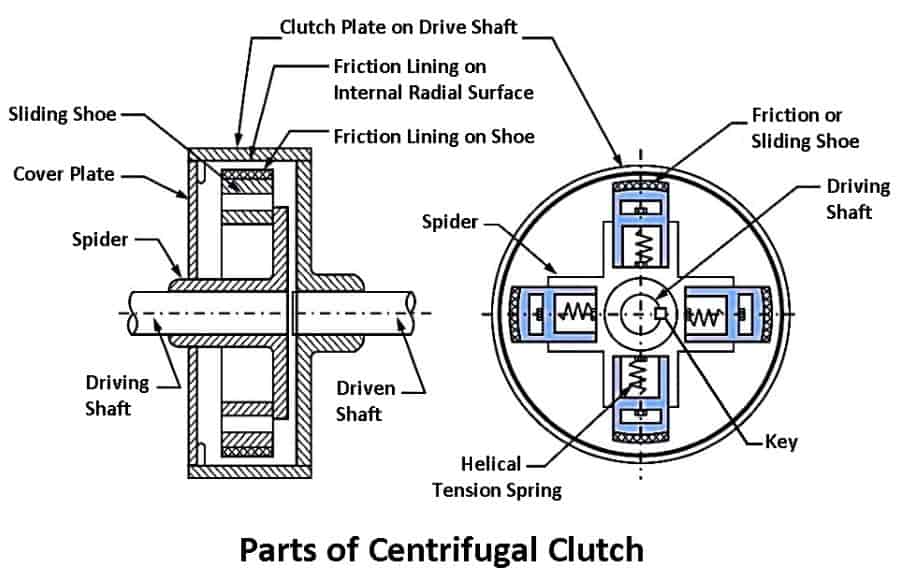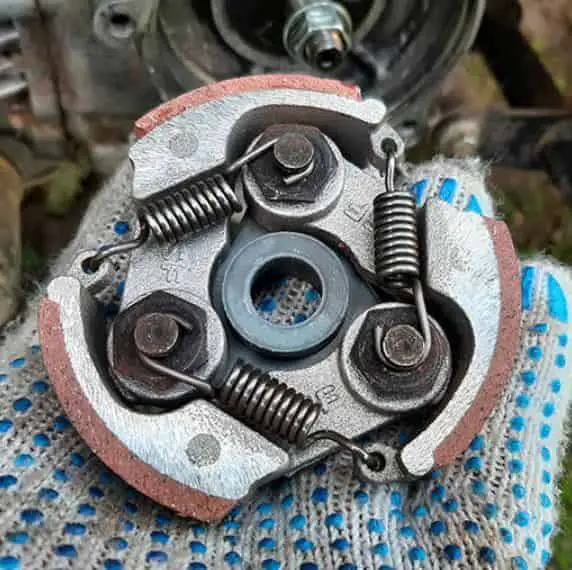In this article, you’ll learn what is centrifugal clutch? Its diagram, parts, working, advantages, and applications all are explained with pictures.
Also, you can download the PDF file at the end of this article.
What is a Centrifugal Clutch?
Centrifugal clutches are mechanical devices designed to transfer the rotational power from an engine to a transmission in a vehicle to facilitate gear changes. The engine’s rotation generates centrifugal force, which is used to engage and disengage the clutch.
Small engines like those in go-karts, mini bikes, underbones, chainsaws, mopeds, and lawnmowers frequently employ this kind of clutch. Due to its simplicity, dependability, and low maintenance requirements, the centrifugal clutch is ideally suited for these applications.
In response to the engine speed changing between acceleration and deceleration, this system automatically engages and disengages the transmission to assist with smooth acceleration and deceleration.
The vehicle’s clutch paddle is not necessary in this type of system to shift the clutch. An engine can be started or stopped by a driver without shifting up or down in gear. When moving at high speed, the centrifugal clutch is more effective.
Read Also: What is a Single Plate Clutch? Diagram, Parts, Working & Applications
Parts of Centrifugal Clutch
The following are the centrifugal clutch’s primary components:
- Drum
- Clutch basket
- Clutch plates
- Springs
- Shoe
- Friction lining
- Spider
- Weights
- Key

#1 Drum
A drum is an outer part of the clutch that rotates in conjunction with the crankshaft of the engine. The drum encloses every component of the clutch, including the guides, sliding shoes, springs, friction lining, and others. The drum is connected to the driven shaft of the belt, chain, or transmission system.
#2 Clutch Basket
As the name suggests, the clutch basket is a stationary part of the clutch system that holds clutch plates until they are needed.
#3 Clutch Plates
From the engine to the transmission, the clutch plate acts as a friction disc to transmit the power from the engine to the transmission.
#4 Springs
A clutch plate is held in place by a clutch spring that applies pressure and helps keep the clutch plates engaged with each other. Spring is typically used at slower speeds. Each shoe has a spring attached to it.
#5 Shoe
When the clutch is engaged, the shoe is a component that is attached to the weights, and it is in contact with the clutch basket when the clutch is engaged. Shoes are a potential source of friction.
The shoe is attached to the guides and functions primarily as a sliding object. The shoes used to slide in guideways. It has a friction lining at the very end.
Read Also: What is Timing Belt in a Car? Their Symptoms & Replacement [PDF]
#6 Friction Lining
A component of the sliding shoes is the friction lining. The friction lining operates on the same logic as a basic clutch’s friction plate. This friction lining can be attached to the outermost portion of shoes.
An inner friction lining transfers torque, making the drum’s inner surface more gripped. The sliding shoes and the drum are kept from coming into direct contact. By doing this, the sliding shoes experience less wear and tear.
#7 Spider
The spider is mounted to either the driver (engine) shaft or the motor shaft. Since there is an equal distance between each spider, there is also an equal distance between each guide.
As an illustration, if three guides are present, the next guide is 90 degrees away from the first guide. The shoes are kept in between these guides to absorb the friction, and each guide has a spring to disengage the clutch.
#8 Weights
The clutch is engaged by weights, which are parts that are fastened to the drum. The weights move outward as the engine speed rises due to centrifugal force and make contact with the clutch basket, engaging the clutch.
#9 Key
The clutch is connected to the engine crankshaft by a key, enabling it to rotate with the engine, and is another crucial component.
Read Also: How does a Multi Plate Clutch work? Diagram, Parts, and Uses [PDF]
Working Principle of Centrifugal Clutch
A centrifugal clutch works by engaging the clutch with centrifugal force. A weight attached to the clutch shoes moves outward as the engine spins, making contact between the shoes and the clutch drum.
An engine’s power is transferred to the driven shaft through this engagement. In situations where the engine speed drops, the weights move inward, disengaging the clutch and allowing the engine to stop without stalling.
Read Also: Understand the Working of Wankel Rotary Engine [Pros & Cons]
Working of Centrifugal Clutch
Centrifugal clutches are automatic clutches that engage and disengage power transmission based on engine speed. In order to operate the clutch mechanism, centrifugal force is used.
Clutch shoes and clutch drums are the two main parts of the clutch. The clutch shoes are attached to the engine’s crankshaft and have a pin that allows them to pivot freely. Typically, the driven shaft is connected to the clutch drum.
When the engine’s RPM increases, the rotating clutch shoes move outward due to centrifugal force. As a result of this motion, the clutch shoes come into contact with the clutch drum’s inner surface.
During contact between the shoes and drum, friction is generated, which causes the clutch drum to spin, transferring power from the engine to the shaft. A decrease in engine RPM lowers centrifugal force, which disengages clutch shoes and stops power transmission.
By using this mechanism, the engine, and transmission will not stall, and wear and tear will be reduced.
Read Also: Leaf Spring Suspension: Diagram, Parts, Types, Uses [PDF]
Types of Centrifugal Clutch
Centrifugal clutches come in a variety of designs, such as:
#1 Drum Type
The most popular kind of centrifugal clutch is the drum-type clutch. The drum-type centrifugal clutch consists of a housing that is shaped like a drum and houses the clutch shoes of the machine, and it is attached to the shaft that receives the input from the machine.
#2 Shoe Type
In this type of clutch, the input shaft of the machine is connected to a rotating plate on which the clutch shoes are mounted. To engage the clutch, the shoes must come into contact with the inner surface of the clutch drum after being pushed outward by centrifugal force.
#3 Cone Type
The input and output shafts of the machine are connected to two cones that serve as the input and output shafts of the cone clutch type. The clutch shoes are situated between the cones; as the input shaft rotates, the shoes are pushed outward and engage the clutch.
#4 Roller Type
Instead of shoes, this clutch engages the clutch using rollers. The rollers are mounted on pins that are joined to the clutch drum. The rollers are pushed outward as the input shaft rotates and makes contact with the clutch drum’s inner surface to engage the clutch.
#5 Diaphragm Type
This kind of clutch engages the clutch using a flexible diaphragm. When the input shaft spins, the diaphragm is drawn outward and contacts the clutch drum, which then engages the clutch mechanism as a result.
Read Also: Different Types of Gearbox: Parts, Working, and Applications
Advantages of Centrifugal Clutch
Utilizing a centrifugal clutch has the following benefits:
- The design of centrifugal clutches is straightforward, and they require little periodic maintenance.
- Centrifugal clutches are extremely reliable and unlikely to malfunction due to their straightforward design.
- As the engine speed rises, the clutch automatically engages, enabling smooth acceleration.
- Centrifugal clutches are relatively affordable in comparison to other types of clutches.
- Since they don’t need any adjustments or involve installation processes, centrifugal clutches are simple to install.
- Due to their lightweight, centrifugal clutches are perfect for small, portable power equipment.
- For uses where a simple, dependable, and low-maintenance clutch system is needed, centrifugal clutches are a great choice.
Read Also: How does a Distributorless Ignition System work? [Explained]
Disadvantages of Centrifugal Clutch
The following are some drawbacks of using a centrifugal clutch:
- Centrifugal clutches are not appropriate for applications requiring a smooth engagement at low speeds because they only engage at a specific engine RPM.
- Because of their limited torque capacity, centrifugal clutches might not be appropriate for heavy-duty applications.
- Since centrifugal clutches are not adjustable, they might not be suitable for tasks that consider precise clutch engagement control.
- Centrifugal clutches lack the ability to slip, which is critical in some situations, like those where the engine must keep running even when the transmission is not engaged.
- Because a centrifugal clutch’s clutch engagement is based on engine RPM, it can be difficult to use in situations where the engine speed changes frequently.
- These clutches are inappropriate for some applications due to their constrained speed range, torque capacity, adjustability, and slip capability.
Read Also: What is Cylinder Head? Parts, Functions, Types and Applications
Application of Centrifugal Clutch
These applications frequently employ centrifugal clutches:

- Go-karts frequently use centrifugal clutches because they offer smooth acceleration and are easy to use.
- Centrifugal clutches are quite often used in mini bikes due to their simplicity and dependability.
- Due to their simple operation and minimal maintenance needs, centrifugal clutches are commonly used in lawnmowers.
- Centrifugal clutches are used in certain agricultural machineries, such as tillers and cultivators, for their reliable and smooth power transmission.
- Due to their low-maintenance operation, centrifugal clutches are used in a variety of small power equipment, including generators and pressure washers.
- To provide a smooth power transmission, these clutches are used in some industrial equipment, including conveyors and material handling systems.
- For stable and low-maintenance operation, centrifugal clutches are used in portable power tools like chainsaws and hedge trimmers.
- Some motorized bicycles use centrifugal clutches to transmit power smoothly and consistently.
Wrapping It Up
For small engine applications where a straightforward and dependable clutch system is needed, centrifugal clutches are the best choice. They are also appropriate for RC model cars and other portable power equipment where lightness and usability are key considerations.
I hope I have covered everything about this article “Centrifugal Clutch. “ If I missed something, or if you have any doubts, let me know in the comments. If you liked this article, please share it with your friends.
Want free PDFs direct to your inbox? Then subscribe to our newsletter.
Download PDF of this article:
You might like to read more in our blog: